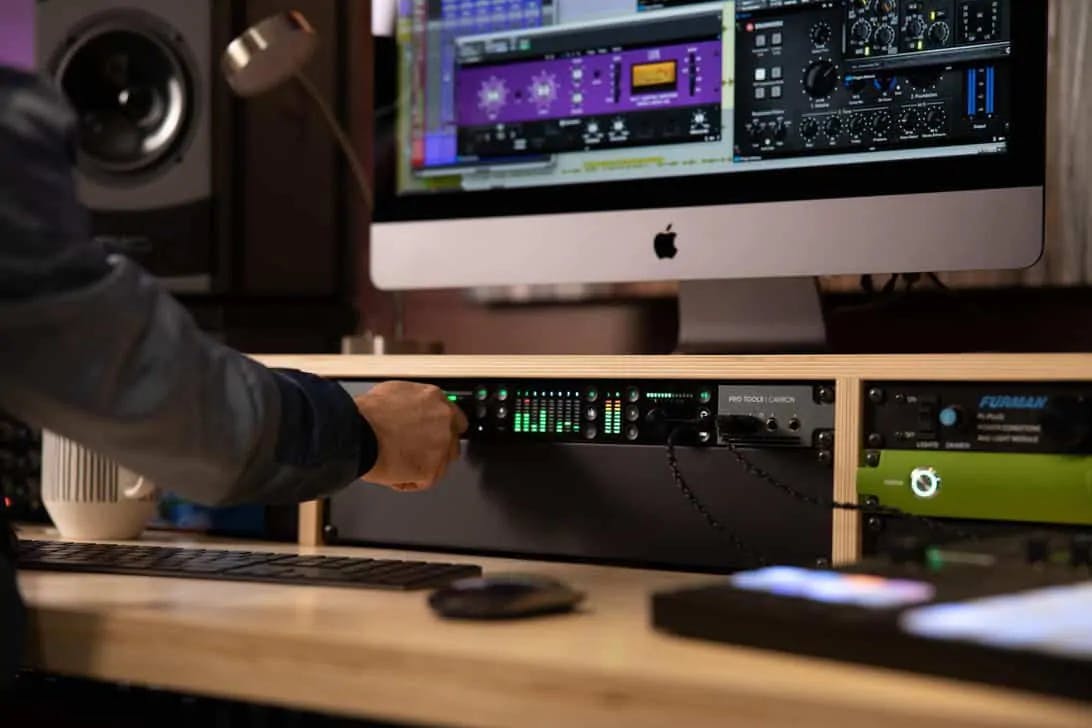- Published on
Avid Carbon vs RME UFX III Interface
- Authors

- Name
- Boomspot
- @Boomspot

Avid Carbon vs RME UFX III Interface
Comparing the Avid Carbon and the RME UFX III interfaces reveals two high-end audio interfaces designed for different user needs and studio environments.
Avid Carbon
Hybrid System: Avid Carbon is a hybrid system combining both native and DSP (Digital Signal Processing) aspects. This system allows low-latency monitoring and DSP-assisted recording within Pro Tools, making it an innovative solution for latency issues.
Pro Tools Integration: Carbon comes with a Pro Tools license and is deeply integrated with the software. Its unique features, like the 'hybrid' concept, are primarily accessible within Pro Tools, although it works with other DAWs too.
I/O Configuration: It offers 25 physical input and 34 output paths, including ADAT optical connectors, a dedicated stereo monitor output, line-level outputs, and multiple headphone outputs.
Sound Quality: The Carbon interface is noted for its excellent sound quality, boasting impressive dynamic range, low THD, and high-quality mic preamps.
DSP Resources: Equipped with eight DSP chips, Carbon is designed for tracking rather than running the entire mixer, which sets it apart from Avid’s HDX system.
RME UFX III:
High Channel Count: The UFX III is a USB 3 Audio Interface with a 188-channel capacity at 24-Bit/192 kHz, offering a higher channel count than its predecessor. It supports a wide range of connection protocols including ADAT, MADI, and DANTE.
Versatile Connectivity: It features a variety of analog and digital connections, including XLR, TRS, AES, MADI, and more, making it highly adaptable for different studio setups.
DURec Functionality: The UFX III includes the DURec feature, allowing direct standalone multitrack recording to external storage devices, which is a unique feature not found in the Carbon.
TotalMix FX Software: This software provides deep-level control over the UFX III, including DSP-based low-latency EQ, dynamics, and effects. It can be remotely controlled, adding flexibility to studio setups.
Audio Quality and Performance: The UFX III is recognized for its clean and natural-sounding preamps and converters, along with easy driver setup and stable performance across various operating systems.
Modular Paradigm: The UFX III supports a modular approach, allowing expansion and integration into various types of studio setups, from MIDI composition rooms to immersive audio environments.
Key Differences:
Target Audience: Carbon is tailored for Pro Tools users, focusing on seamless integration and low-latency recording within this ecosystem. UFX III, on the other hand, offers a broader range of connectivity and is more versatile for different DAWs and studio environments.
Hybrid vs. Traditional Interface: Carbon's hybrid system is a unique feature, primarily benefiting Pro Tools users. In contrast, UFX III does not rely on a hybrid system but offers a more traditional interface with an extensive range of I/O options and remote control capabilities.
DSP Utilization: Carbon utilizes DSP for low-latency monitoring and DSP-assisted tracking, whereas UFX III's DSP capabilities are more focused on onboard effects and mixing through the TotalMix FX software.
In summary, Avid Carbon is ideal for users deeply invested in the Pro Tools ecosystem, seeking a low-latency recording solution with excellent sound quality. The RME UFX III is more versatile, suitable for various DAW environments and studio setups, with a focus on high channel count, connectivity, and remote control functionality. The choice between them depends largely on the user's preferred DAW, studio setup requirements, and specific feature needs.
Avid Carbon vs RME UFX III Interface Spec Sheet Comparison
General Features
- Brand & Model
- Avid Carbon
- RME UFX III
Audio Specifications
- Simultaneous I/O
- Avid Carbon: 25 x 34
- RME UFX III: [Not specified in the provided document]
- Audio Resolution
- Avid Carbon: Up to 32-bit, 192 kHz
- RME UFX III: [Not specified, but likely similar given industry standards]
- Mic Preamps
- Avid Carbon: 8
- RME UFX III: 4 (Microphone In 9-12, front)
- Phantom Power
- Avid Carbon: +48V
- RME UFX III: [Not specified]
Connectivity
- USB/Firewire
- Avid Carbon: 2 AVB Ethernet ports
- RME UFX III: USB 3.0
- Digital I/O
- Avid Carbon: ADAT, Word Clock I/O
- RME UFX III: MADI, AES/EBU, ADAT, SPDIF, Word Clock
Additional Features
- DSP/FPGA Processing
- Avid Carbon: 8 HDX DSP processors
- RME UFX III: [Not specified]
- Form Factor
- Avid Carbon: 1U rack
- RME UFX III: [Not specified]
- Dimensions
- Avid Carbon: 1.8 x 19 x 13.5 inches
- RME UFX III: [Not specified]
- Weight
- Avid Carbon: 17.3 lbs
- RME UFX III: [Not specified]
Technical Specifications
- A/D and D/A Conversion
- Avid Carbon: Dynamic Range up to 126 dB, THD+N as low as -113 dB
- RME UFX III: Dynamic Range up to 118.5 dBA, THD+N as low as -110 dB
- Frequency Response
- Avid Carbon: 20 Hz–20 kHz, ±0.1 dB
- RME UFX III: Varies, up to 3 Hz – 89 kHz
What’s Included
- Avid Carbon
- Pro Tools | Carbon audio interface, Pro Tools Ultimate license, plugin bundle, power and Ethernet cables, rackmount screws, and desktop feet.
- RME UFX III
- [Not specified in the provided document, typically includes the interface unit and possibly power and USB cables]